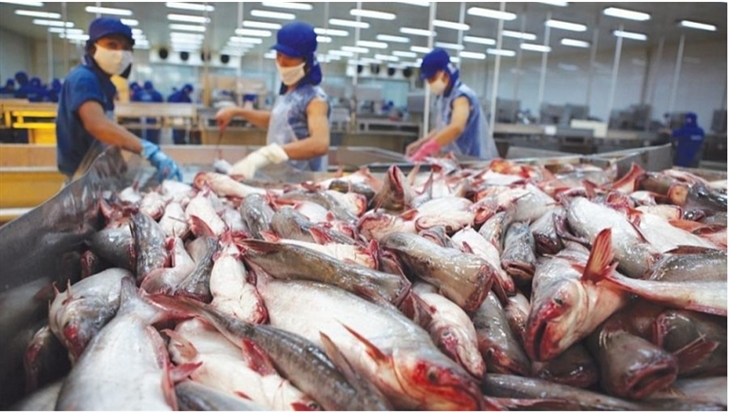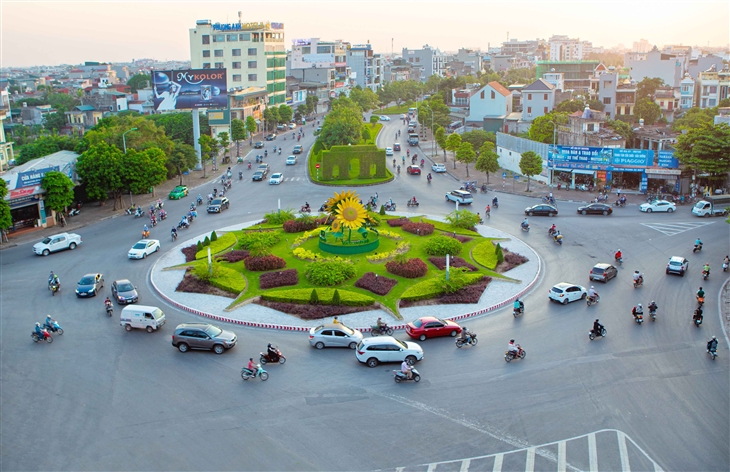Seafood industry flexibly markets exports
Monday, June 16,2025
AsemconnectVietnam - Diversifying and developing niche markets, promoting deep processing, the seafood industry's export target of 11 billion USD this year will not be too difficult.
Seafood exports grow by 14%
Seafood exports in the first 5 months of 2025 reached 4.07 billion USD, up 14% over the same period last year. Currently, the 3 largest export markets for Vietnamese seafood are China, the United States and Japan, accounting for 20%, 16%, and 15% of the market share, respectively. Shrimp and pangasius continue to be Vietnam's main seafood export products.
Despite good export growth, Vietnamese seafood is facing many challenges as export markets increasingly tighten technical standards, quarantine, and requirements for sustainable development. In addition, climate change, water pollution, and diseases, especially luminous shrimp disease, have greatly affected output and quality. At the same time, facing fierce competition from other seafood suppliers such as India, Ecuador, and Indonesia, Vietnamese seafood needs to increase output and quality, especially in the low-cost segment.
In this context, businesses are aiming for flexibility in export markets. As a pangasius exporter to about 30 markets, Mr. Phan Hoang Duy - Deputy General Director of Can Tho Seafood Import-Export Joint Stock Company (Caseamex) - said that the company is proactively shifting exports to EU and Asian markets.
Diversifying markets, or in other words, not putting all eggs in one basket, diversifying processed products is also being implemented by Go Dang Joint Stock Company. Mr. Nguyen Van Dao - General Director of Go Dang Joint Stock Company - said that in the past time, the company has proactively sought new customers and new orders, so the company's production activities have been maintained continuously. In difficult times, it will also be an opportunity for the company to consolidate and affirm its position. Promoting deep processing, developing niche markets
However, taking advantage of the free trade agreement (FTA), along with reducing costs, is a key issue for the Vietnamese seafood industry. Mr. Trinh Trung Phi - Deputy General Director of Technical Department of Commercial Shrimp of Viet Uc Group - said that the key issue is that we must create socially responsible products and the product price must be low. "Currently, the price of Vietnamese seafood products is still high because the input is produced through many stages, many layers, many levels", Mr. Phi said.
Experts in the industry also said that state management agencies need to upgrade technical infrastructure, logistics systems to reduce transportation costs for businesses, and businesses need to diversify products to reduce pressure on traditional products.
For example, for pangasius products, businesses do not only make frozen fillets, but also need to consider options developed in the direction of diversification: Fish balls, sausages, seasoned pangasius, braised fish boxes, pangasius rolls, pangasius sushi, ... to serve the need for fast and convenient food, especially in Asian cities such as Japan, Korea, Singapore, Malaysia. In addition, products such as fried fish skin, fish oil, collagen, gelatin, and animal feed from by-products are becoming new trends.
Regarding pangasius products, the Vietnam Association of Seafood Exporters and Producers (VASEP) stated that the world is changing, and the Vietnamese pangasius industry also needs to change. Niche markets that were once overlooked can now be new "gold mines" if you know how to approach them, understand their needs, and are ready to adapt.
“Vietnam has signed 17 FTAs with many major partners in the world, including new-generation FTAs (FTAs) such as CPTPP, EVFTA, UKVFTA. These FTAs bring many benefits to Vietnam, including market expansion, access to advanced technology and improved competitiveness. This is a "passport" that helps pangasius easily penetrate demanding markets," VASEP commented, adding that consumers in the EU and North America are increasingly prioritizing green, sustainable, fully certified products. Pangasius raised according to organic processes, ASC, BAP, GlobalG.A.P, or according to the circular economy standard (RAS) can be priced 1.5 - 2 times higher than regular products. Potential niche markets named by VASEP include: Muslim markets; African markets; South American market (except Brazil);… According to VASEP, Vietnam has initially penetrated Brazil but the rest of South America is still a "lowland" in terms of pangasius imports. Taste compatibility and convenient eating trends are big pluses. The launch of FTA negotiations between Vietnam and Mercosur will be a strategic "springboard" to expand market share.
This year, the seafood industry aims to reach an export target of 11 billion USD. Diversifying markets, diversifying export products, and expanding to niche markets will be important directions for the seafood industry to maintain growth momentum and increase product added value.
Talking to reporters of the Industry and Trade Newspaper, Mr. Phung Duc Tien - Deputy Minister of Agriculture and Environment - said that in the context of a volatile world, market diversification is not only an urgent requirement in the short term but also a long-term strategy.
Mr. Phung Duc Tien also noted that businesses need to review and focus on developing potential products in large markets such as China, while strengthening quality control, reducing costs, improving processing capacity and promoting trade. Improving the "health" of the industry is the foundation for the sustainable development of the Vietnamese seafood industry in a volatile global competitive environment.
Source: Vitic/ congthuong.vn
Seafood exports in the first 5 months of 2025 reached 4.07 billion USD, up 14% over the same period last year. Currently, the 3 largest export markets for Vietnamese seafood are China, the United States and Japan, accounting for 20%, 16%, and 15% of the market share, respectively. Shrimp and pangasius continue to be Vietnam's main seafood export products.
Despite good export growth, Vietnamese seafood is facing many challenges as export markets increasingly tighten technical standards, quarantine, and requirements for sustainable development. In addition, climate change, water pollution, and diseases, especially luminous shrimp disease, have greatly affected output and quality. At the same time, facing fierce competition from other seafood suppliers such as India, Ecuador, and Indonesia, Vietnamese seafood needs to increase output and quality, especially in the low-cost segment.
In this context, businesses are aiming for flexibility in export markets. As a pangasius exporter to about 30 markets, Mr. Phan Hoang Duy - Deputy General Director of Can Tho Seafood Import-Export Joint Stock Company (Caseamex) - said that the company is proactively shifting exports to EU and Asian markets.
Diversifying markets, or in other words, not putting all eggs in one basket, diversifying processed products is also being implemented by Go Dang Joint Stock Company. Mr. Nguyen Van Dao - General Director of Go Dang Joint Stock Company - said that in the past time, the company has proactively sought new customers and new orders, so the company's production activities have been maintained continuously. In difficult times, it will also be an opportunity for the company to consolidate and affirm its position. Promoting deep processing, developing niche markets
However, taking advantage of the free trade agreement (FTA), along with reducing costs, is a key issue for the Vietnamese seafood industry. Mr. Trinh Trung Phi - Deputy General Director of Technical Department of Commercial Shrimp of Viet Uc Group - said that the key issue is that we must create socially responsible products and the product price must be low. "Currently, the price of Vietnamese seafood products is still high because the input is produced through many stages, many layers, many levels", Mr. Phi said.
Experts in the industry also said that state management agencies need to upgrade technical infrastructure, logistics systems to reduce transportation costs for businesses, and businesses need to diversify products to reduce pressure on traditional products.
For example, for pangasius products, businesses do not only make frozen fillets, but also need to consider options developed in the direction of diversification: Fish balls, sausages, seasoned pangasius, braised fish boxes, pangasius rolls, pangasius sushi, ... to serve the need for fast and convenient food, especially in Asian cities such as Japan, Korea, Singapore, Malaysia. In addition, products such as fried fish skin, fish oil, collagen, gelatin, and animal feed from by-products are becoming new trends.
Regarding pangasius products, the Vietnam Association of Seafood Exporters and Producers (VASEP) stated that the world is changing, and the Vietnamese pangasius industry also needs to change. Niche markets that were once overlooked can now be new "gold mines" if you know how to approach them, understand their needs, and are ready to adapt.
“Vietnam has signed 17 FTAs with many major partners in the world, including new-generation FTAs (FTAs) such as CPTPP, EVFTA, UKVFTA. These FTAs bring many benefits to Vietnam, including market expansion, access to advanced technology and improved competitiveness. This is a "passport" that helps pangasius easily penetrate demanding markets," VASEP commented, adding that consumers in the EU and North America are increasingly prioritizing green, sustainable, fully certified products. Pangasius raised according to organic processes, ASC, BAP, GlobalG.A.P, or according to the circular economy standard (RAS) can be priced 1.5 - 2 times higher than regular products. Potential niche markets named by VASEP include: Muslim markets; African markets; South American market (except Brazil);… According to VASEP, Vietnam has initially penetrated Brazil but the rest of South America is still a "lowland" in terms of pangasius imports. Taste compatibility and convenient eating trends are big pluses. The launch of FTA negotiations between Vietnam and Mercosur will be a strategic "springboard" to expand market share.
This year, the seafood industry aims to reach an export target of 11 billion USD. Diversifying markets, diversifying export products, and expanding to niche markets will be important directions for the seafood industry to maintain growth momentum and increase product added value.
Talking to reporters of the Industry and Trade Newspaper, Mr. Phung Duc Tien - Deputy Minister of Agriculture and Environment - said that in the context of a volatile world, market diversification is not only an urgent requirement in the short term but also a long-term strategy.
Mr. Phung Duc Tien also noted that businesses need to review and focus on developing potential products in large markets such as China, while strengthening quality control, reducing costs, improving processing capacity and promoting trade. Improving the "health" of the industry is the foundation for the sustainable development of the Vietnamese seafood industry in a volatile global competitive environment.
Source: Vitic/ congthuong.vn
Imports of goods from US continued to grow
First batch of lychees exported to Japan, wide market outlet
Exploiting billion-dollar market from agricultural by-products
Main commodity groups exported to Egypt in first 5 months of 2025
FDI increased sharply in first 5 months of 2025
Pepper prices soar by more than 60%, exports surge
Consumer price index increased slightly in May
7 commodity groups with export value of billions of USD in May
Exporting fruits and vegetables to China: Choosing quality for long haul
Pepper exports increased sharply in value, decreased in volume
Vietnam's import-export and trade balance in first 5 months of 2025
Top 5 localities with the highest industrial production index
Rice exports in first 5 months of 2025
Vietnam’s industrial index in first 5 months of 2025

Plan of Hai Duong province for a period of 2021 - 2030, ...
Organize space reasonably and harmoniously, focusing on connecting Hai Duong in common development space, actively contributing to the ...Plan of Hau Giang province in a period of 2021 - 2030, ...
Sustainable forestry development program in a period of ...

Art programme honouring Ao dai opens at HCM City Book ...
An art programme to honour and promote traditional cultural values and the beauty and grace of Ao dai has opened in Ho Chi Minh City. It ...From Hanoi to Brussels – a cross-cultural musical journey
Talented youngsters to enjoy int'l football ...
Tien Linh, Thuy Trang win Vietnam Golden Ball 2024
HCM City’s ao dai festival to feature mass folk dance with ...



